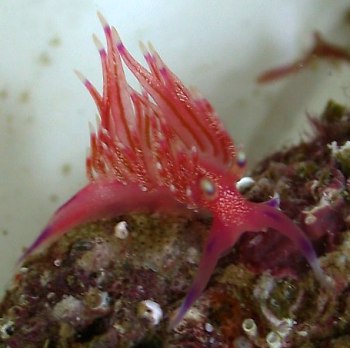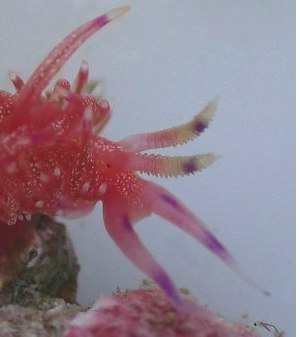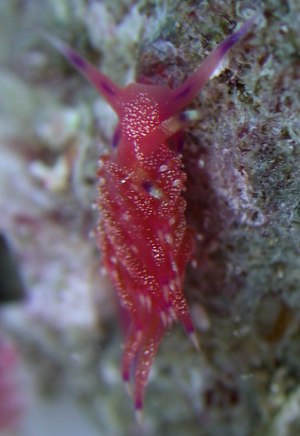Flabellina cynara from Mexico
April 1, 2002
From: Alicia Hermosillo

Dear Dr. Rudman,
Here is some information and pictures on Flabellina cynara, a beautiful species we have over here.
The photos are of a 7 mm specimen collected 40 feet deep at Playa Mismaloya (Bahia de Banderas, Mexico), a place I call "Noche de la Iguana" because it is the location where a famous 1970s Elizabeth Taylor movie "The Night of the Iguana" was shot.
This species is commonly called the 'Swimming Cynara', and to quote Hans Bertsch:
"Most memorable is the swimming behavior of Flabellina cynara, which was so brilliantly illustrated by Wesley Farmer in his 1970 paper, "Swimming Gastropods (Opisthobranchia and Prosobranchia)" (The Veliger, 13: 80-83). The slug uses back-and-forth strokes of its whiplike cerata to propel itself through the water. The cerata gently curl forward in a loosely coordinated flowing movement, pause, and then whip backwards in a simultaneous power wave. The rearward flipping of the cerata is the propulsive stroke. Swimming up into the water column may allow the animal to hitch a ride on the water currents, aiding its escape from a predator or its search for prey or a mate".
Its body is of deep pink with white spots and it has very long and thin, salmon-orange cerata with white speckling and a subterminal purple ring. The border of the foot has a rich purple marginal line. The translucent cephalic tentacles have a distal purple blotch. It grows to about 40-50 mm long. Before my present studies, this species was only known to the northern Gulf of California, Mexico (Puerto Penasco and Guaymas, Sonora, on mainland Mexico; and Bahia de los Angeles, Baja California). This range extension has not yet been published.
Alicia
alicia_titan@infosel.net.mx


Dear Ali,
Thanks for sharing this beautiful animal.
Bill Rudman
Related messages
-
Re: Flabellina cynara from Mexico
From: Alicia Hermosillo, November 17, 2005 -
Re: Flabellina cynara from Peru
From: Dave Behrens, November 16, 2005 -
Re Flabellina cynara & B. bertschi
From: Dave Behrens, November 16, 2005
